Introduction and a bit of History
The Hind is possibly the best known Soviet helicopter to those
of us in the west. Developed during the late 60's by the Mil
Design Bureau in Moscow, the prototype V-24 first flew in 1969
and entered active service some years later. Nemeth Designs have
based their model on the Mi-24V (Hind-E), the most widely
produced version with more than 1,500 made. Originally derived
from the Mi-8 (Hip), the Hind's design incorporated the roles of
gunship and attack helicopter together with the ability to carry
up to 8 troops. Used since the 70's by more than 60 nations,
including the United States, the Hind is still in active service
around the globe – a tribute to its designers.
 Soviet Air Force |
 GDR Air Force |
At just over 250 Mb, downloading the Hind was no problem. Installation was equally easy, with the Mi-24 model's folders correctly located in my FSX system when checked. Only 1 folder, titled ND_MI24 had been installed and no additions to either of the main FSX Sound or Effects folders. I also installed the revised specular mapping from the support forum at http://aussiex.org/forum/index.php?/files/file/4001-nd-mi-24-revised-spec-mapping/
Mi-24V Models and Aircraft Variants
Nemeth Designs' Hind comes in 4 versions:
• Soviet Air Force (unarmed)
• GDR Air Force (unarmed)
• Afghan Air Force
• Sri Lanka Air Force
The Afghan and Sri Lanka Air Force models show 2 pods of unguided 55 mm rockets under each wing, together with twin missile tubes (empty). Each of the 4 variants are distinguished by individual service camouflage markings.
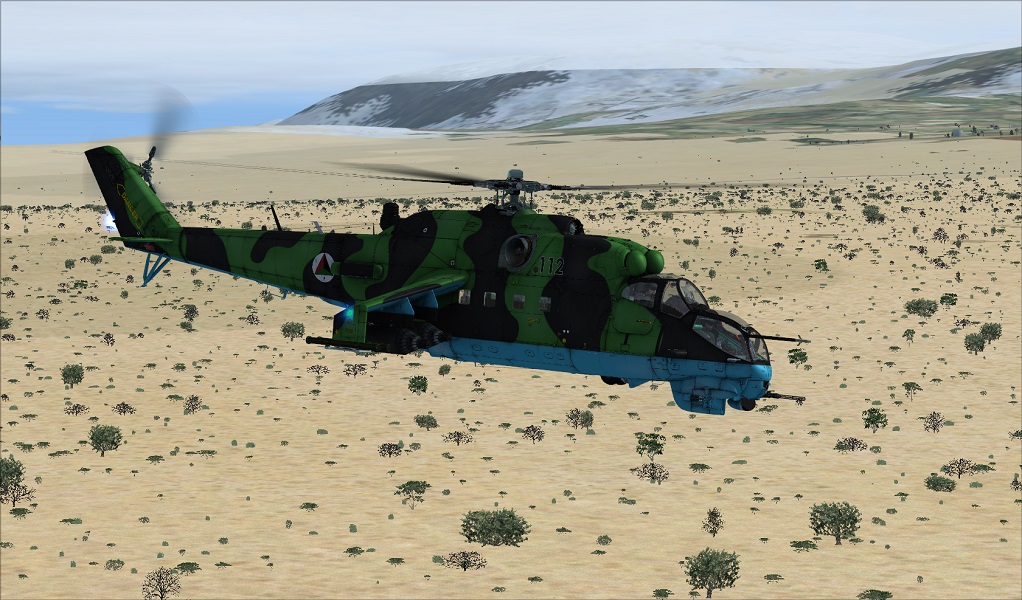 Afghan Air Force |
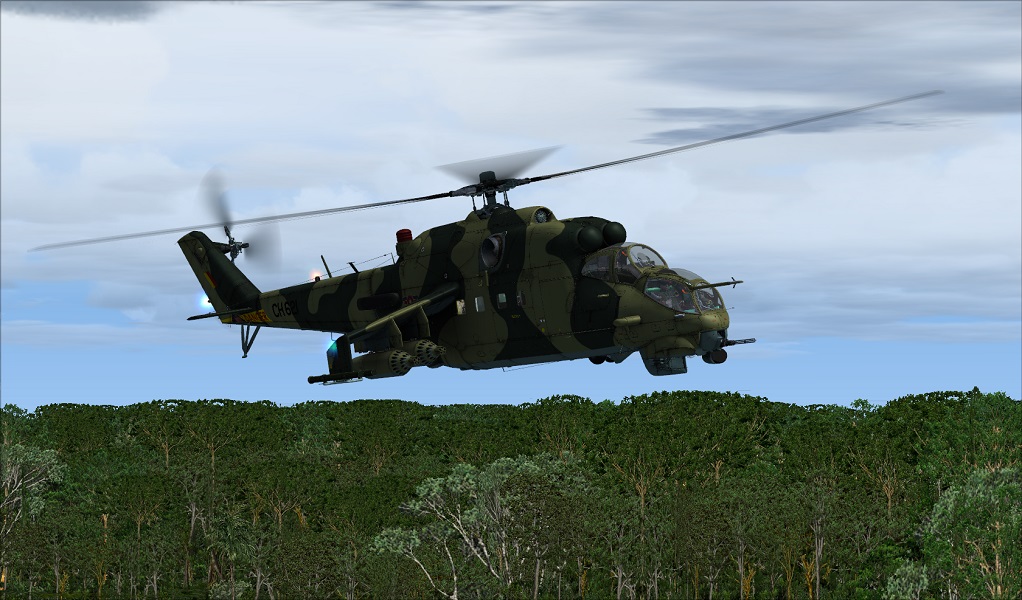 Sri-Lanka Air Force |
After a quick look at the manual, more of which later, I fired up FSX and selected my favourite airport for helicopter flying – Missoula Intl (KMSO). In FSX, the Hind loads with engines running – no start-up procedure to follow – and you're good to go. Before taking off, I made a brief inspection. Make no mistake, the ND Hind, like its real life counterpart, is an impressive beast. Externally, it simply exudes aggression and you can understand how it got the nickname “Krokodil”.
Internally, the virtual cockpits (commander/pilot and gunner/co-pilot) exhibit a truly incredible attention to detail. All the VC gauges are modelled in 3-D, as you'd expect, and nearly all the switches and knobs are animated.
But how would the Hind behave? To find out, I settled back in the commander's seat and lifted the collective...
The aircraft rises surprisingly rapidly for its weight, so you need to be smooth with the collective. Above ground effect, you get the usual pendulum motion – but that's fairly easy to correct as you gain a little speed. Turning needs a combination of bank and pedal which, again, is relatively straightforward. The Hind picks up speed and height quickly, as you'd expect of a military helicopter, and I had to lower the collective and flare a little in order to offset this. The Hind manoeuvres quite predictably once you've got the basic flight dynamics under control – practice makes perfect! After a few attempts, I was even able to land the Hind on a raised platform, a fitting end to my preliminary test flight.
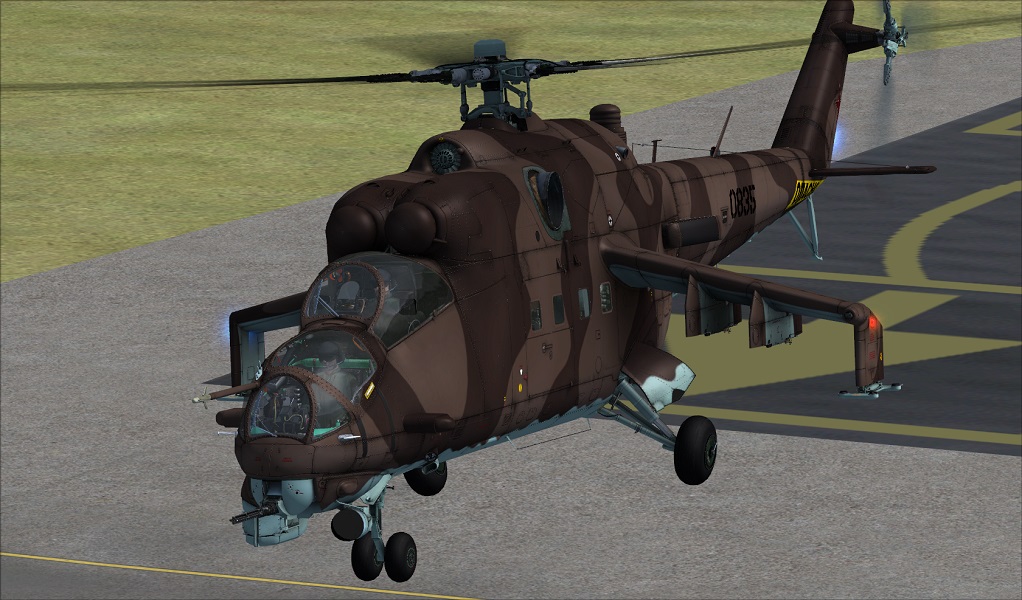 Leaving Helipad KMSO |
 Platform KMSO |
Here is a video of my first Impressions:
If this video does no work for you, the direct link is //vimeo.com/75429507
External Model
All 4 variants are presented in camouflage livery and the texture detail is excellent. The landing gear animation is very well executed, responding realistically on take-off and touch-down. The modelling of the main and rear rotors is incredibly detailed. The textures applied to the motion of the rotors are also well designed and add significantly to the realism. In addition to the armaments, the Hind has a range of external equipment, including forward machine gun and 12.7 mm cannon, laser range finder and radar warning receiver, chaff/flare launch modules and antennae. All in all, the Hind external model is a real credit to the developer.
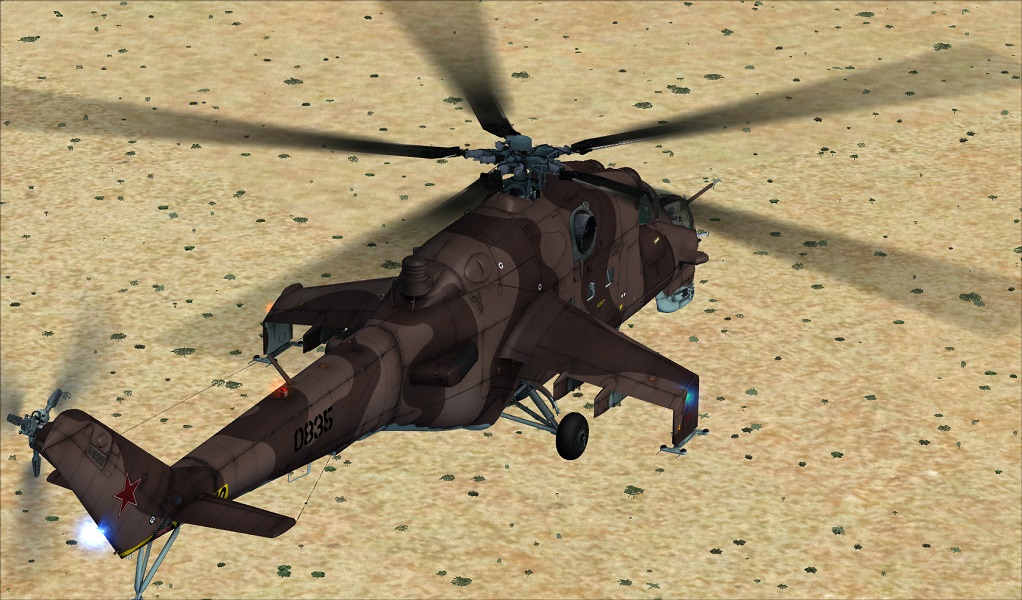 Detail Above |
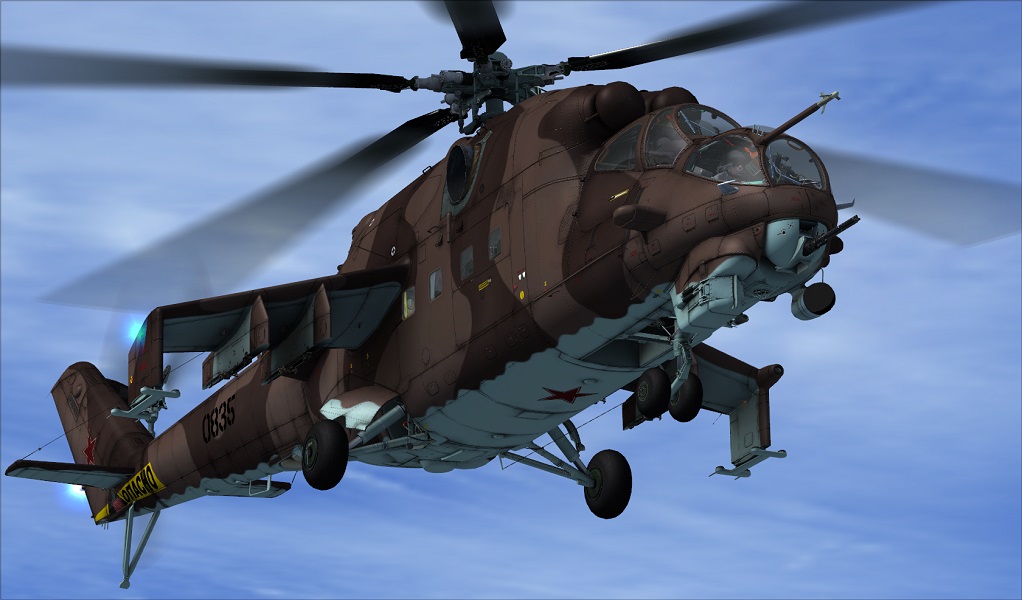 Detail Below |
Interior Model (Virtual Cockpit etc)
The commander sits behind and above the gunner and this is the main VC in the model. Ahead are the main flight gauges with the weapons systems below. To the left you'll first find hydraulics, landing gear and flight assist controls and then radio, navigation, fuel and engine controls. To the right of the flight instruments is the main engine panel and beyond that electronic sub-systems. The Gunner can fly the Hind as co-pilot and sits in the front section of the tandem cockpit. Ahead are his targeting and observational systems controls with the armament control panel to the left.
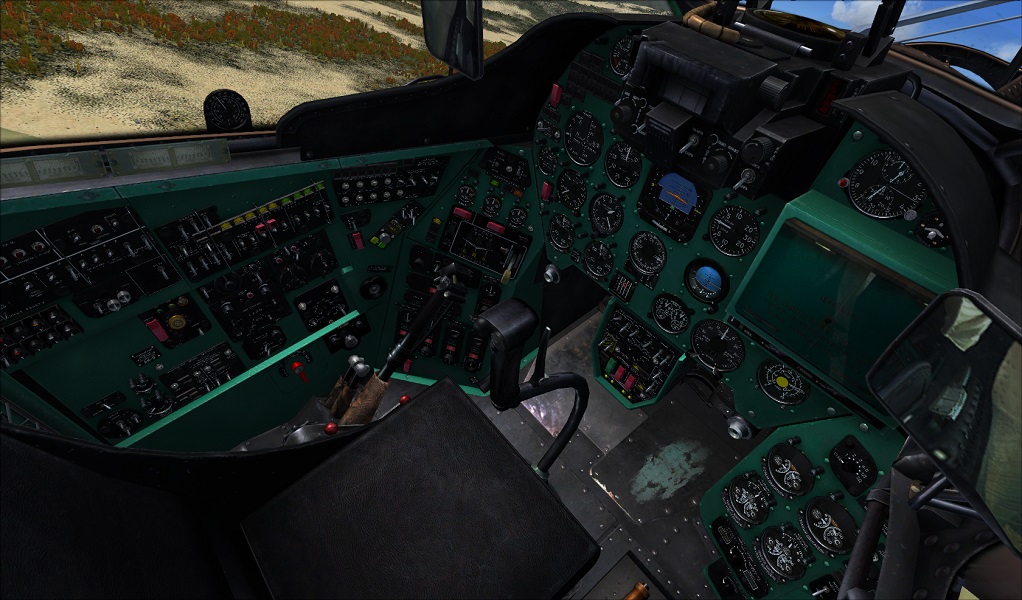 VC Commanders Cockpit |
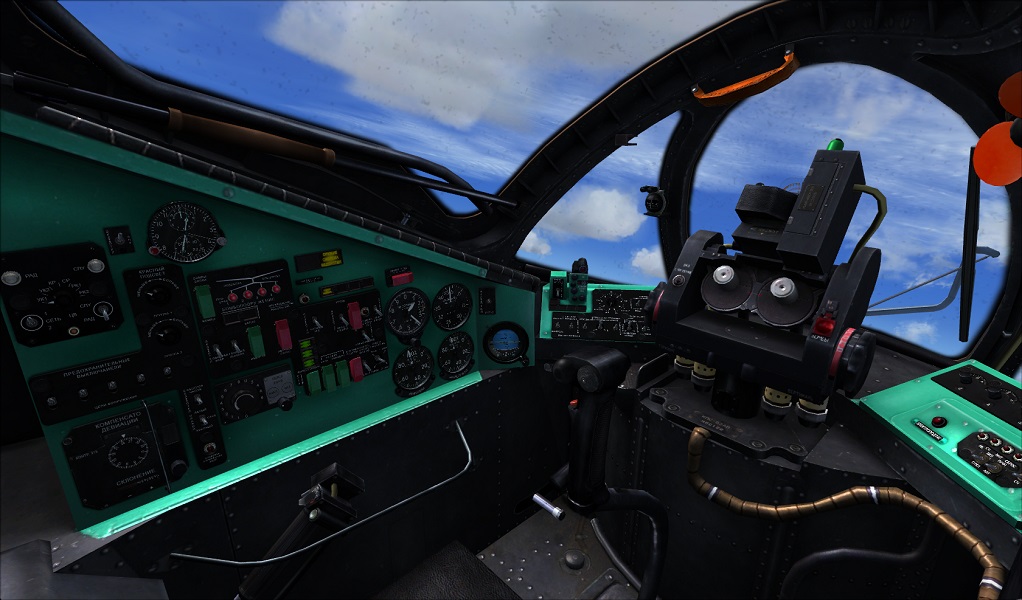 VC Gunners Cockpit |
The standard of 3-D modelling of the Hind's gauges is very high and as good as I've seen on any payware helicopter. The use of cyrillic script legends on instruments and switches is absolutely realistic. The Hind Manual does identify each dial/switch/knob – and you will need to familiarise yourself with the cyrillic script until Nemeth implement tool-tips for the VC , but this is to be rectified shortly so, hopefully, you won't have to learn Russian!
 Commanders Panel Detail |
 Commanders Panel Night |
At night, the VC Panel Lights show clearly for instrument flying and navigation. Infra-red assistance is not available with the Hind, so night sorties are not easy, but possible if you are familiar with the surrounding terrain. The landing lights, like the panel lights, need to be switched on and off from the VC – another reason for reading the manual in some detail as keyboard and joystick assignments appear to be disconnected.
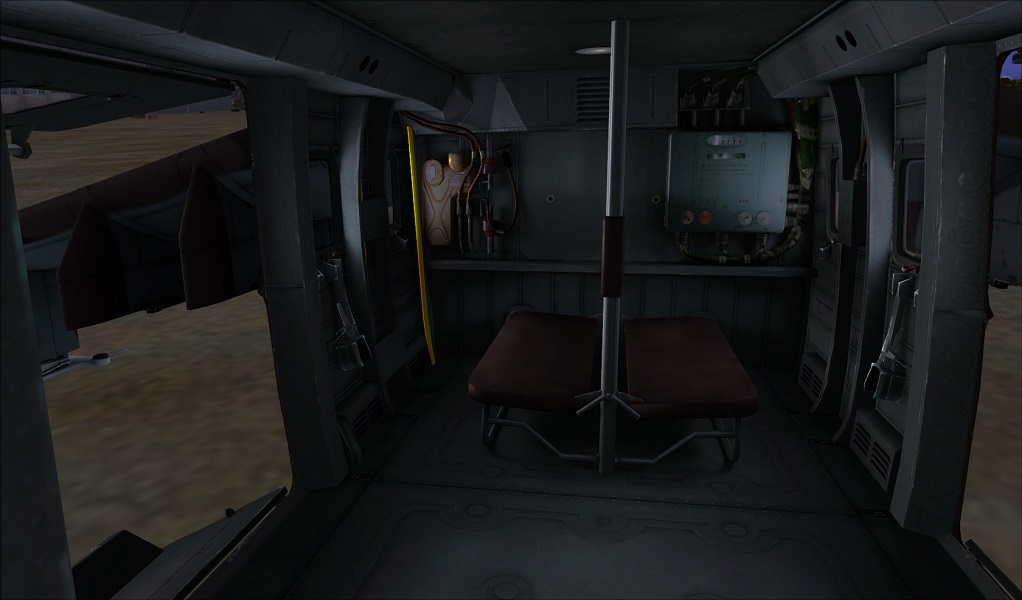 Cabin Detail |
 Night Landing Lights |
As stated previously, the Hind reacts sensitively to your collective input, so some care needs to be taken on take-off and landing. Once airborne, the Hind flies quite predictably and, at low speeds, turning with pedal and cyclic is straightforward. At speeds above 80 kph, however, the pedals seem to have no effect. This is similar to the flight dynamics of the default Agusta EH-101 and on inspection you will find that the ND Hind air file is based on the EH-101, as is the aircraft.cfg. Whilst this is, perhaps, a little disappointing at a technical level, the developers have clearly preferred to concentrate on the visual aspects rather than research and implement a more realistic flight dynamics model for the Hind. Thus, the effect of the cockpit's angular rotation from the main fuselage is ignored. Other characteristics, like retreating blade stall shuddering and vortex ring, are absent, as you'd expect with a model using the default FSX helicopter simulation flight dynamics.
Sound and Animations
The Hind's sound set is from Sonic Solutions and cover every operational aspect including turbine start-up/shut-down, under-carriage touch-down and crash effects. I particularly liked the external sounds, which are very realistic. Apart from being perhaps a little on the quiet side, the one sound I missed was that of the main rotor during flight as it was much quieter than the whine of the turbo-shafts.
Under-carriage and rotors apart, the only other animations outside the cockpit are the four doors: front and aft cockpit, together with the port and starboard entries to the main passenger cabin. These animations are more than adequate, but it is unfortunate that the armaments (guns and missiles) do not operate, particularly considering the offensive nature of the Hind's main military role.
 Door Animation |
 Main Rotor Animation |
My system specification is relatively average (see below for details) and so I wasn't surprised that the frame rate dipped below 20 FPS when flying in the VC above anything more complex than fairly bare default scenery. Around Hover Control's KMSO airport, I got around 15 FPS in the VC, but, switching to external view (which I don't fly with in helicopters) frame rate went back up to around 25 FPS. If your system is up-to-date, the Hind shouldn't be a problem unless you're using very highly populated scenery.
PDF Manual
Nemeth Designs have presented the Hind manual in vintage format – manually typed on faded paper. I was grateful it wasn't printed in russian! Seriously, the pdf file is quite comprehensive and covers historical as well as technical matters. The Hind's various systems are described in great detail as is the function of each gauge and switch in each of the tandem cockpits. There's also a detailed set of checklists covering pre-flight, engines start and shut-down. Also included are sections on take-off, cruise, manoeuvres and landing, together with reference tables on limiting flight parameters.
I found the manual straightforward to read and it was a very useful reference. But, like all detailed manuals, you will need to set aside time to read it, particularly as many of the default FSX keyboard short-cuts (i.e. Instrument and landing lights etc) seem not to be implemented in the Hind.
Pluses and Minuses
Visually, the Nemeth Designs Hind is excellent – both externally and internally and cannot be faulted (assuming the tool-tips will be introduced). Sound levels were perhaps a little muted and the lack of external equipment animation detracted a bit from the overall effect of the Hind's operational role. I would have preferred the Hind's flight dynamics to be less like the Agusta EH-101, but perhaps development costs constrained this aspect – and, anyway, unless you've flown the real aircraft (which I clearly haven't!), you'd be pushed to make precise comparisons.
Concluding Remarks
Nemeth Designs have produced a great version of the Hind – one which will serve as a bench-mark for others, particularly in respect of external detail. Internally, the VC is as complex as any cockpit (fixed or rotary wing) that I've seen. It's an excellent helicopter to fly in FSX being both a demanding and an enjoyable experience. If you're at all interested in military helicopters, you will certainly want the Hind in your hangar.
| Verdict: |
 |
|
| • External Model: | 10/10 | |
| • Internal Model: | 10/10 | |
| • Sounds + Animations: | 7.0/10 | |
| • Flight Dynamics: | 6.0/10 | |
| • Documentation: | 8.0/10 | |
| • Value for Money: | 8.0/10 |
| Mutley’s Hangar score of 8.2 /10, "Recommended" and a Mutley's Hangar Bronze Award. |
Q9400 2.67 GHz | 4Gb Ram |nVidia GeForce 8800 GT 512 Mb |Windows 7 64bit
